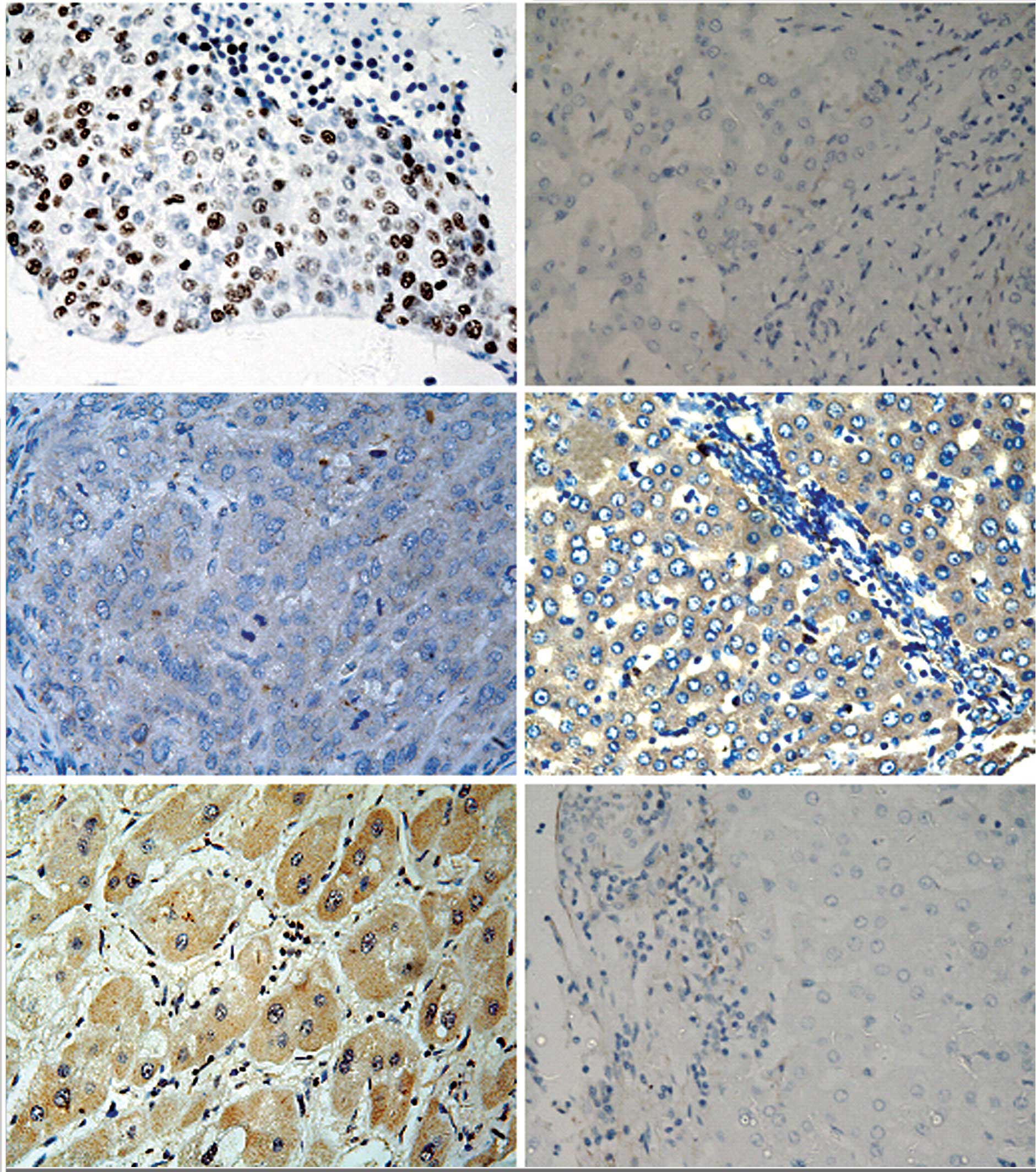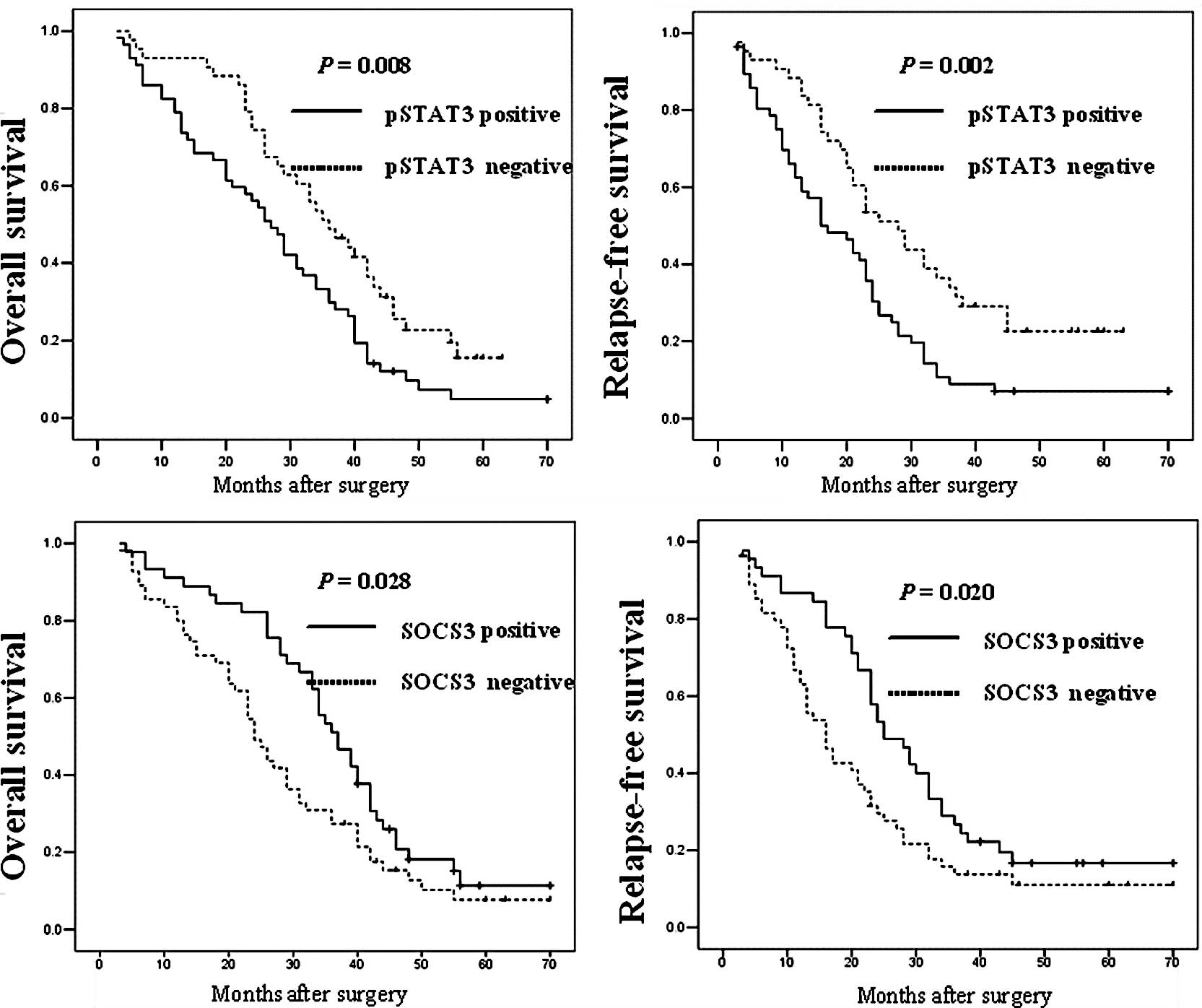|
1.
|
He J, Gu D, Wu X, et al: Major causes of
death among men and women in China. N Engl J Med. 353:1124–1134.
2005. View Article : Google Scholar : PubMed/NCBI
|
|
2.
|
Hirano T, Ishihara K and Hibi M: Roles of
STAT3 in mediating the cell growth, differentiation and survival
signals relayed through the IL-6 family of cytokine receptors.
Oncogene. 19:2548–2556. 2000. View Article : Google Scholar : PubMed/NCBI
|
|
3.
|
Valentino L and Pierre J: JAK/STAT signal
transduction: regulators and implication in hematological
malignancies. Biochem Pharmacol. 71:713–721. 2006. View Article : Google Scholar : PubMed/NCBI
|
|
4.
|
Buettner R, Mora LB and Jove R: Activated
STAT signaling in human tumors provides novel molecular targets for
therapeutic intervention. Clin Cancer Res. 8:945–954.
2002.PubMed/NCBI
|
|
5.
|
Bowman T, Garcia R, Turkson J and Jove R:
STATs in oncogenesis. Oncogene. 19:2474–2488. 2000. View Article : Google Scholar : PubMed/NCBI
|
|
6.
|
Yu H and Jove R: The STATs of cancer – new
molecular targets come of age. Nat Rev Cancer. 4:97–105. 2004.
|
|
7.
|
Kanda N, Seno H, Konda Y, et al: STAT3 is
constitutively activated and supports cell survival in association
with survivin expression in gastric cancer cells. Oncogene.
23:4921–4929. 2004. View Article : Google Scholar : PubMed/NCBI
|
|
8.
|
Choi JH, Ahn MJ, Park CK, Han HX, Kwon SJ,
Lee YY and Kim IS: Phospho-Stat3 expression and correlation with
VEGF, p53, and Bcl-2 in gastric carcinoma using tissue microarray.
APMIS. 114:619–625. 2006. View Article : Google Scholar : PubMed/NCBI
|
|
9.
|
Yang SF, Wang SN, Wu CF, Yeh YT, Chai CY,
Chunag SC, Sheen MC and Lee KT: Altered p-STAT3 (tyr705) expression
is associated with histological grading and intratumour microvessel
density in hepatocellular carcinoma. J Clin Pathol. 60:642–648.
2007. View Article : Google Scholar : PubMed/NCBI
|
|
10.
|
Deng JY, Sun D, Liu XY, Pan Y and Liang H:
STAT-3 correlates with lymph node metastasis and cell survival in
gastric cancer. World J Gastroenterol. 16:5380–5387. 2010.
View Article : Google Scholar : PubMed/NCBI
|
|
11.
|
Kim HS, Park YH, Lee J, Ahn JS, Kim J,
Shim YM, Kim JH, Park K, Han J and Ahn MJ: Clinical impact of
phosphorylated signal transducer and activator of transcription 3,
epidermal growth factor receptor, p53, and vascular endothelial
growth factor receptor 1 expression in resected adenocarcinoma of
lung by using tissue microarray. Cancer. 116:676–685. 2010.
View Article : Google Scholar
|
|
12.
|
Huang WT, Yang SF, Wu CC, Chen WT, Huang
YC, Su YC and Chai CY: Expression of signal transducer and
activator of transcription 3 and suppressor of cytokine signaling 3
in urothelial carcinoma. Kaohsiung J Med Sci. 25:640–646. 2009.
View Article : Google Scholar : PubMed/NCBI
|
|
13.
|
Kile BT and Alexander WS: The suppressors
of cytokine signalling (SOCS). Cell Mol Life Sci. 58:1627–1635.
2001. View Article : Google Scholar : PubMed/NCBI
|
|
14.
|
Bai L, Yu Z, Qian G, Qian P, Jiang J, Wang
G and Bai C: SOCS3 was induced by hypoxia and suppressed STAT3
phosphorylation in pulmonary arterial smooth muscle cells. Respir
Physiol Neurobiol. 152:83–91. 2006. View Article : Google Scholar : PubMed/NCBI
|
|
15.
|
O’Shea JJ, Gadina M and Schreiber RD:
Cytokine signaling in 2002: new surprises in the Jak/Stat pathway.
Cell. 109:S121–S131. 2002.PubMed/NCBI
|
|
16.
|
Edmondson HA and Steiner PE: Primary
carcinoma of the liver: a study of 100 cases among 48, 900
necropsies. Cancer. 7:462–503. 1954. View Article : Google Scholar : PubMed/NCBI
|
|
17.
|
Wu ZS, Wu Q, Yang JH, Wang HQ, Ding XD,
Yang F and Xu XC: Prognostic significance of MMP-9 and TIMP-1 serum
and tissue expression in breast cancer. Int J Cancer.
122:2050–2056. 2008. View Article : Google Scholar : PubMed/NCBI
|
|
18.
|
Wu ZS, Wu Q, Wang CQ, Wang XN, Wang Y,
Zhao JJ, Mao SS, Zhang GH, Zhang N and Xu XC: MiR-339-5p inhibits
breast cancer cell migration and invasion in vitro and may be a
potential biomarker for breast cancer prognosis. BMC Cancer.
10:5422010. View Article : Google Scholar : PubMed/NCBI
|
|
19.
|
Li Y, de Haar C, Chen M, Deuring J,
Gerrits MM, Smits R, Xia B, Kuipers EJ and van der Woude CJ:
Disease-related expression of the IL6/STAT3/SOCS3 signalling
pathway in ulcerative colitis and ulcerative colitis-related
carcinogenesis. Gut. 59:227–235. 2010. View Article : Google Scholar : PubMed/NCBI
|
|
20.
|
Brown DC and Gatter KC: Ki67 protein: the
immaculate deception? Histopathology. 40:2–11. 2002. View Article : Google Scholar
|
|
21.
|
Yang SF, Yeh YT, Wang SN, Hung SC, Chen
WT, Huang CH and Chai CY: SOCS-3 is associated with vascular
invasion and overall survival in hepatocellular carcinoma.
Pathology. 40:558–563. 2008. View Article : Google Scholar : PubMed/NCBI
|
|
22.
|
Niu G, Wright KL, Huang M, et al:
Constitutive Stat3 activity up-regulates VEGF expression and tumor
angiogenesis. Oncogene. 21:2000–2008. 2002. View Article : Google Scholar : PubMed/NCBI
|
|
23.
|
Alexander WS and Hilton DJ: The role of
suppressors of cytokine signaling (SOCS) proteins in regulation of
the immune response. Annu Rev Immunol. 22:503–529. 2004. View Article : Google Scholar : PubMed/NCBI
|
|
24.
|
Yoshimura A, Nishinakamura H, Matsumura Y
and Hanada T: Negative regulation of cytokine signaling and immune
responses by SOCS proteins. Arthritis Res Ther. 7:100–110. 2005.
View Article : Google Scholar : PubMed/NCBI
|
|
25.
|
He B, You L, Uematsu K, Zang K, Xu Z, Lee
AY, Costello JF, McCormick F and Jablons DM: SOCS-3 is frequently
silenced by hypermethylation and suppresses cell growth in human
lung cancer. Proc Natl Acad Sci USA. 100:14133–14138. 2003.
View Article : Google Scholar : PubMed/NCBI
|
|
26.
|
Yu ZB, Bai L, Qian P, Xiao YB, Wang GS,
Qian GS, Bai CX and Min JX: Restoration of SOCS3 suppresses human
lung adenocarcinoma cell growth by downregulating activation of
Erk1/2, Akt apart from STAT3. Cell Biol Int. 33:995–1001. 2009.
View Article : Google Scholar : PubMed/NCBI
|
|
27.
|
Croker BA, Krebs DL, Zhang JG, et al:
SOCS3 negatively regulates IL-6 signaling in vivo. Nat Immunol.
4:540–545. 2003. View
Article : Google Scholar : PubMed/NCBI
|
|
28.
|
Ying M, Li D, Yang L, Wang M, Wang N, Chen
Y, He M and Wang Y: Loss of SOCS3 expression is associated with an
increased risk of recurrent disease in breast carcinoma. J Cancer
Res Clin Oncol. 136:1617–1626. 2010. View Article : Google Scholar : PubMed/NCBI
|
|
29.
|
Nakagawa T, Iida S, Osanai T, Uetake H,
Aruga T, Toriya Y, Takagi Y, Kawachi H and Sugihara K: Decreased
expression of SOCS-3 mRNA in breast cancer with lymph node
metastasis. Oncol Rep. 19:33–39. 2008.PubMed/NCBI
|
|
30.
|
Sakai I, Takeuchi K, Yamauchi H, Narumi H
and Fujita S: Constitutive expression of SOCS3 confers resistance
to IFN-alpha in chronic myelogenous leukemia cells. Blood.
100:2926–2931. 2002. View Article : Google Scholar : PubMed/NCBI
|
|
31.
|
Brender C, Lovato P, Sommer VH, Woetmann
A, Mathiesen AM, Geisler C, Wasik M and Ødum N: Constitutive SOCS-3
expression protects T-cell lymphoma against growth inhibition by
IFNalpha. Leukemia. 19:209–213. 2005. View Article : Google Scholar : PubMed/NCBI
|











